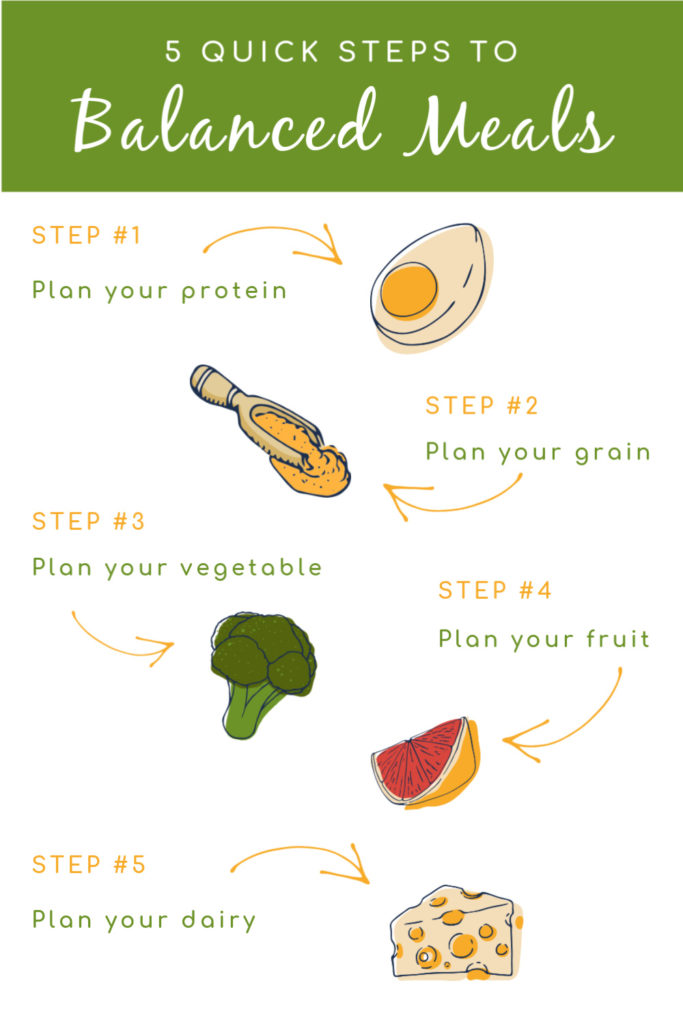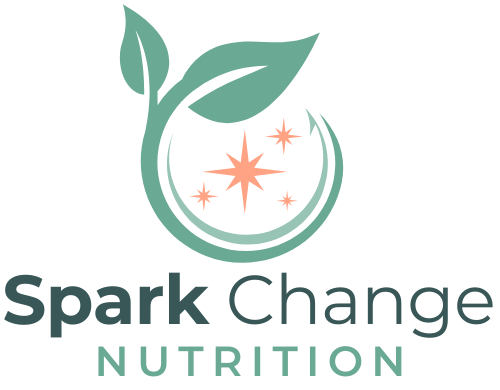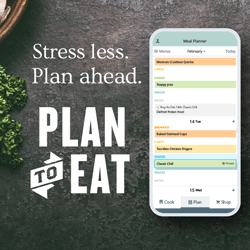In my last post, I talked about why now is the perfect time to start a meal planning habit. It discussed the logistics of meal planning. In today’s post, we’re going to take a deep dive into how to meal plan. Planning balanced meals is a lot simpler than you might think.
What food group should I start with?
This graphic makes it super easy to remember what order to go in. However, this is not a “rule” to be followed religiously. It is just a suggested course of action.

Start with the protein group . . .
When meal planning, I usually start with the protein food. There’s a few reasons for this:
It helps ensure a satisfying meal.
In America, the protein group tends to be the star of the show. We feel like something is missing if we don’t have a protein on our plate.
Protein is also satisfying on a biological level, in that it helps us to feel full after eating. It also moves through our digestive tract slower than carbs do, so it helps us to eat less often.1
It can speed up the rest of your meal planning.
Oftentimes the protein group is part of a mixed dish (a “mixed dish” meaning that it contains more than one type of food group). If you start by planning that first, you will automatically be able to check off some of your other food groups without having to do any additional work. Some examples of this would be shepherd’s pie, chicken enchiladas, or quiche. If you are planning a broccoli and cheese quiche, then you’ve already got your protein (egg), dairy (milk and cheese), and vegetable (broccoli) squared away.
It can help to keep food costs down.
Protein also tends to be the most expensive food group, especially if you’re eating meat. If you plan to use a pricier type of protein for the main dish, then you can balance out the cost by serving less expensive options for the sides.
. . . but not always
Then again, these are just guidelines, and I don’t always follow this order myself. For instance, if I have a particular food I want to highlight or use up, I will start with that. This week I’ve been craving roasted radishes, so I will plan a meal around those. In the past, I’ve served them with chicken, since I feel like those pair well together. Depending on my mood, I may plan to roast some chicken in the oven, or just buy a rotisserie chicken from the grocery store if I am feeling lazy.
Starting with a particular food item you want to highlight also works well if you receive your produce from a CSA or through an online delivery service, like Imperfect Foods. That’s because these services will often give you random produce that may not pair well with what you usually eat. When that happens, I suggest starting by finding a recipe to use that produce item. Once you’ve got that chosen, you can figure out an entree to match. In my experience, these services will also give you recipes or cooking suggestions to go with their less common offerings, so this can actually be a fun way to expand your cooking repertoire.
What should I plan next?
Once you’ve got the protein food chosen, I usually go in the following order:
- Choose your grain – because grains also tend to be at the center of American meals, so I’ve found it’s easiest to plan this group next.
- Choose your vegetable – because you want to make sure you have a vegetable! And vegetables are often part of the main meal, versus being more of a bonus at the end.
- Choose your fruit – because I think of fruits more like dessert, so I put them at the end.
- Choose your dairy – because sometimes dairy doesn’t naturally fit in well with a meal. In that case, I may add a cup of soy milk or a serving of Greek yogurt with some fresh fruit on top for dessert. Also, on the MyPlate model, dairy sits off to the side, so I think my brain has just been trained to think of it last.
You’re talking a lot about food groups, how do I know what those are?
The number one resource I recommend for learning about the food groups is ChooseMyPlate.gov. It has anything and everything you can think of when it comes to food groups (and balanced eating). If you’re not sure how much you should be eating every day, they also have super handy guides here. This is a great starting point for anyone who wants to learn more about nutrition.
Where can I get ideas from?
When I’m meal planning, I usually start by brainstorming in one of a few different ways:
- I look at menus from prior weeks, to remind myself of things I made before and that my family liked. (I’ve been using the app Plan to Eat for years, and so I have my history stored there for easy access.)
- I write down a list of foods that I know my family likes. For instance, my six-year-old always enjoys macaroni and cheese and bean and cheese burritos, and my husband likes pretty much anything with red meat.
- Sometimes I’ll start by listing out a bunch of protein foods, like chicken, beans, or ground beef, and then brainstorm ways to prepare those, or think up other food groups to pair them with.
- I ask my six-year-old to flip through a kid-friendly cookbook and pick out a few things that he thinks that he or his brother would like.
- I peruse the cookbooks on my shelf, then grab a few that strike my fancy. Once I’ve got them, I browse through and note which recipes I like and their page numbers.
- If I’m feeling really uninspired, I’ll Google it. Depending on what type of food I’m looking for, I may do a search for “easy weeknight dinners”, “kid-friendly meals”, etc. Check out this post I did with a roundup of recipe websites.
- If I know I’ve got food I need to use up, I’ll stick my head in the pantry, freezer, and/or fridge and make a quick list of foods that I’ve already got on hand.
As you can see, there are a lot of places to begin. Find what inspires you, and start there.
How do I write out my meal plan?
I recommend writing out your meal plan in any way that works for you. You can download a template off the Internet (find mine here), use a bullet journal, keep a planner devoted to meal planning, or just use a tear-off paper pad with the days of the week on it. You can also do it online with software (again, I use Plan to Eat). You can write on Post-it notes and stick them to the fridge. The system doesn’t matter. What matters is that it is easy for you and that you like doing it enough that you will actually use it.
Do I have to plan every single food group at every single meal?
No! This would get super tedious and overwhelming. It’s okay to not eat every single food group at every single meal. The nice thing about our bodies is that they can be nourished by eating a balance of foods over the course of a day or week. Maybe you have a giant salad for lunch, so you skip vegetables in favor of fruit at dinner. That’s just fine.
A good rule of thumb: aim to have at least three food groups at every meal. This will help to ensure a balance of nutrients. I recommend choosing at least one good source of protein at each meal. Foods in the dairy group or the protein group will provide this. I also recommend choosing at least one produce item, so pick either a fruit or a vegetable. For your third group, you can either double up on one of the above (if you picked a protein, then have a dairy too, or if you picked a fruit, have a vegetable too). Alternatively, you can choose an item from the grain group.
Final tips
Tip 1 – Start small
As with any type of behavior change, when starting a meal planning habit, I recommend starting small. Baby steps are the best way to build a habit. If you’re brand new to meal planning, or you’re intimidated at the prospect, then try to plan just 1 or 2 meals in advance. You will gradually build confidence. You can do this!
Tip 2 – Keep copies of your meal plans
I highly recommend keeping copies of any meals that you plan out. This can help you in a few ways:
- You can make notes on the meal plan, indicating what you liked or didn’t like, or what worked or didn’t work. In my family, I have picky eaters, so I keep notes on who liked what.
- You can use these meal plans for future inspiration, when you’re stuck coming up with ideas. They are also helpful when you remember liking a recipe, but you can’t remember where you got it from.
- Once you have enough meals planned, you can put them together into an amazing package called a cycle menu. This is simply a meal plan that repeats after a certain length of time. If your kids have ever brought home their school lunch menu and you’ve noticed that it repeats, then that’s a cycle menu. Businesses use these all the time (work cafeterias, hospitals, daycares, schools, nursing homes, etc.). If you make one for your home, it can facilitate meal planning, grocery purchases, and budgeting around food.
Tip 3 – Do what works for you
And remember, there is no one right way to meal plan. Just like a lot of recommendations regarding nutrition and health, it is important to individualize things so that they work for you. Meal plan in a way that suits you. The goal is to get balanced meals on the table, not to be perfect.
What meal planning strategies have worked for you?
Share them in the comments below.
This post originally appeared on the site coronavirusmealplans.com on April 28, 2020
References
1Duyff, R. L. (2017). Academy of Nutrition and Dietetics Complete Food and Nutrition Guide, 5th Ed (5th Revised & Updated ed., p. 377). Mariner Books.







0 Comments